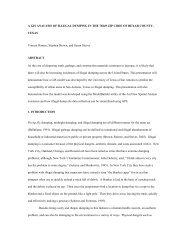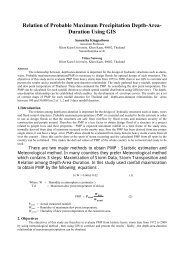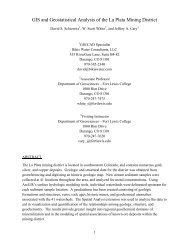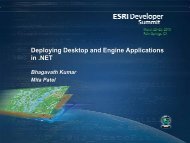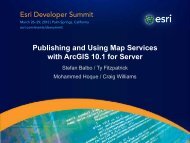ArcGIS Server Performance and Scalability - Optimization and ... - Esri
ArcGIS Server Performance and Scalability - Optimization and ... - Esri
ArcGIS Server Performance and Scalability - Optimization and ... - Esri
You also want an ePaper? Increase the reach of your titles
YUMPU automatically turns print PDFs into web optimized ePapers that Google loves.
<strong>ArcGIS</strong> <strong>Server</strong> <strong>Performance</strong> <strong>and</strong> <strong>Scalability</strong>-<br />
<strong>Optimization</strong> <strong>and</strong> Testing<br />
Andrew Sakowicz, <strong>Esri</strong> Professional Services
Objective<br />
• Overview:<br />
- Key performance factors<br />
- <strong>Optimization</strong> techniques<br />
- Testing Methodology
Audience<br />
• Audience<br />
- Testers<br />
- Developers<br />
- System Architects<br />
• Level:<br />
- Intermediate
<strong>Performance</strong> Factors in <strong>ArcGIS</strong> <strong>Server</strong> Components<br />
• <strong>ArcGIS</strong> <strong>Server</strong> services<br />
• Data Sources<br />
• <strong>ArcGIS</strong> <strong>Server</strong> Framework<br />
• Client applications (Flex, Silverlight, JS, ADF)<br />
• Hardware<br />
Goal: Deliver highly performing deployments.<br />
deployments
<strong>Performance</strong> Factors: <strong>ArcGIS</strong> <strong>Server</strong> Services
<strong>Performance</strong> Factors: <strong>ArcGIS</strong> <strong>Server</strong> Services<br />
Map Service – Source document optimization<br />
• Keep map symbols simple<br />
• Scale dependency<br />
• Optimize spatial index<br />
• Simplify data<br />
• Avoid re-projections on the fly<br />
• Optimize map text <strong>and</strong> labels for performance<br />
• Use annotations<br />
• Avoid wavelet compression-based raster types<br />
(MrSid,JPEG2000)<br />
• Use fast joins (no cross db joins)
<strong>Performance</strong> Factors: <strong>ArcGIS</strong> <strong>Server</strong> Services<br />
Map Service – Output image format choices<br />
• PNG8/24/32<br />
- Transparency support<br />
- 24/32 good for anti-aliasing, rasters with many colors<br />
- Lossless: Larger files ( > disk space/b<strong>and</strong>width, longer<br />
downloads)<br />
• JPEG<br />
- Basemap layers (no transparency support)<br />
- Much smaller files
<strong>Performance</strong> Factors: <strong>ArcGIS</strong> <strong>Server</strong> Services<br />
Map Service – Source map document optimizations, scale dependency<br />
• <strong>Performance</strong> linearly related to number of features
<strong>Performance</strong> Factors: <strong>ArcGIS</strong> <strong>Server</strong> Services<br />
Map Service – Cache generation<br />
- Optimized services create caches significantly faster than “Classic
<strong>Performance</strong> Factors: <strong>ArcGIS</strong> <strong>Server</strong> Services<br />
Geoprocessing Service<br />
• Pre-compute intermediate steps when possible<br />
• Use local paths to data <strong>and</strong> resources<br />
• Avoid unneeded coordinate transformations<br />
• Add attribute indexes<br />
• Simplify data<br />
Detailed instructions on the Resource Center
<strong>Performance</strong> Factors: <strong>ArcGIS</strong> <strong>Server</strong> Services<br />
Image Service<br />
• Tiled, JPEG compressed TIFF is the best (10-400% faster)<br />
• Build pyramids for raster datasets <strong>and</strong> overviews for<br />
mosaic datasets (new at 10.0)<br />
• Tune mosaic dataset spatial index.<br />
• Use JPGPNG request format in Web <strong>and</strong> Desktop clients<br />
- Returns JPEG unless there are transparent pixels (best<br />
of both worlds).<br />
Help Topic: “<strong>Optimization</strong> Considerations for <strong>ArcGIS</strong> Image <strong>Server</strong>”
<strong>Performance</strong> Factors: <strong>ArcGIS</strong> <strong>Server</strong> Services<br />
Geocode Service<br />
• Use local instead of UNC locator files.<br />
• Services with large locators take a few minutes to<br />
“warm-up”<br />
• New 10.0 Single Line Locators offer simplicity in<br />
address queries but might be slower than traditional<br />
point locators.
<strong>Performance</strong> Factors: <strong>ArcGIS</strong> <strong>Server</strong> Services\<br />
Mobile Service<br />
• Document Preparation<br />
- Minimize operational layers<br />
- Cache basemap layers<br />
• Service Configuration<br />
- Try to keep total service cache size under 250 MB<br />
• Usage considerations<br />
- Avoid batch postings in favor of frequent updates
<strong>Performance</strong> Factors: <strong>ArcGIS</strong> <strong>Server</strong> Services<br />
Feature/Geodata Service – Database maintenance is key<br />
• Database Maintenance/Design<br />
- Keep versioning tree small, compress, schedule<br />
synchronizations, rebuild indexes <strong>and</strong> have a well-<br />
defined data model<br />
• Geodata Service Configuration<br />
- <strong>Server</strong> Object usage timeout (set larger than 10 min<br />
default)<br />
- Upload/Download default IIS size limits (200K<br />
upload/4MB download)<br />
• Feature Service<br />
- Trade-off between client-side rendering <strong>and</strong> sending<br />
large amounts of data over the wire.
<strong>Performance</strong> Factors: Machine Architecture<br />
Select adequate hardware to support desired performance/load<br />
• CPU<br />
- Select for intended use<br />
- Mapping: highest Baseline CINT Rate/Core<br />
- GP: highest Baseline CFP Rate/Core<br />
- Sizing<br />
- Published CPU benchmarks:<br />
http://www.spec.org/cpu2006/results/cint2006.html<br />
- Published CPU-limited ESRI benchmarks:<br />
http://resources.esri.com/enterprisegis/index.cfm?fa=codeG<br />
allery<br />
subscript t = target<br />
subscript b = benchmark<br />
ST = CPU service time<br />
TH = throughput<br />
%CPU = percent CPU
<strong>Performance</strong> Factors: Data Sources<br />
Select data storage format that provides optimal performance<br />
Data storage format<br />
- RDBMS, FileGDB, Shapefile, SDC
<strong>Performance</strong> Factors: Data Location<br />
Select data location that provides optimal performance<br />
– Local to SOC machine<br />
– UNC (protocol + network latency/b<strong>and</strong>width<br />
penalties)<br />
– All disks being equal, locally sourced data results in better<br />
throughput.
<strong>Performance</strong> Factors: DB Management<br />
Optimize DB configuration <strong>and</strong> conduct maintenance<br />
• DBMS configuration<br />
• Create <strong>and</strong> maintain (rebuild) attribute indexes<br />
• Updating DBMS statistics<br />
• Versioning management<br />
- Reconcile <strong>and</strong> post<br />
- Compress<br />
Non- Non optimal DBMS may be a source of significant performance degradation<br />
degradation
<strong>Performance</strong> Factors: <strong>ArcGIS</strong> <strong>Server</strong> Framework<br />
Web Service Components – Web Service H<strong>and</strong>lers<br />
• Under high load, easily overloaded by MIME data<br />
(REST/SOAP returning MIME)<br />
- Network saturation<br />
- 72 cores can approach 40% Gigabit utilization<br />
- Network I/O (full-duplex)<br />
- CPU utilization<br />
• Use multiple Web Instances
<strong>Performance</strong> Factors: <strong>ArcGIS</strong> <strong>Server</strong> Framework<br />
Web Service Components – Virtual Directories<br />
• Under high load, virtual output directory bottlenecks<br />
- Network saturation<br />
- Disk performance<br />
• Use multiple output directories on different<br />
machines.
<strong>Performance</strong> Factors: <strong>ArcGIS</strong> <strong>Server</strong> Framework<br />
Web Service Components - MIME vs. URL return type<br />
• For serving maps, MIME can scale better than URL<br />
• Disk/UNC shares often bottlenecks before network<br />
b<strong>and</strong>width<br />
• MIME performs better with smaller images
<strong>Performance</strong> Factors: <strong>ArcGIS</strong> <strong>Server</strong> Framework<br />
Web Services - Security<br />
• SSL<br />
• LSASS<br />
- http://support.esri.com/index.cfm?fa=knowledgebase.te<br />
charticles.articleShow&d=32620<br />
• Web Tier Security<br />
- User/Role Stores<br />
- Token <strong>Server</strong>
<strong>Performance</strong> Factors: <strong>ArcGIS</strong> <strong>Server</strong> Framework<br />
SOC<br />
Optimal number of instances/core departs from CPU-<br />
limited value of 1 by choice of source data<br />
type/location.
Tuning Primer
<strong>Performance</strong> tuning<br />
• Benefits<br />
- Improved performance - user experience<br />
- optimize the use of critical resources – scalability<br />
• Tools<br />
- Fiddler<br />
- Mxdperfstat<br />
- Map Service Publishing Toolbar<br />
- DBMS trace
Tuning Primer<br />
Profile user transaction response time<br />
Total Response<br />
Time (t1-t2)<br />
Wait Time<br />
Usage Time<br />
Search &<br />
Retrieval Time<br />
Browser<br />
t1 t2<br />
Web <strong>Server</strong><br />
SOM<br />
SOC<br />
SDE/DBMS<br />
A test is executed at the web<br />
browser.<br />
It measures web browser call’s<br />
elapsed time (roundtrip between<br />
browser <strong>and</strong> data source)
Tuning Primer<br />
Web diagnostic tools: Fiddler, Tamperdata, Yslow
Tuning Primer<br />
Web diagnostic tools: Fiddler<br />
• Can validate image returned
Tuning Primer<br />
Web diagnostic tools: Fiddler<br />
• Underst<strong>and</strong> each request URL<br />
• Verify cache requests are from virtual directory, not<br />
dynamic map service<br />
• Validate host origin (reverse proxy)<br />
• Profile each transaction response time
Tuning Primer<br />
Web diagnostic tools: Fiddler<br />
HTTP Request<br />
HTTP Response<br />
Inspector Tab
Tuning Primer<br />
Web diagnostic tools: Fiddler (NeXpert Report)
Tuning Primer<br />
Analyze SOM/SOC statistics<br />
Total Response<br />
Time (t1-t2)<br />
Wait Time<br />
Usage Time<br />
Search &<br />
Retrieval Time<br />
Browser<br />
t1 t2<br />
Web <strong>Server</strong><br />
SOM<br />
SOC<br />
SDE/DBMS<br />
Analyze AGS context server<br />
statistics using ArcCatalog, Manager<br />
or logs They provide aggregate <strong>and</strong><br />
detailed information to help reveal<br />
the cause of the performance<br />
problem.
Tuning Primer<br />
Analyze SOM/SOC statistics<br />
• ArcCatalog<br />
• Detailed log - set to verbose<br />
Executing<br />
query.<br />
Feature count: 27590<br />
End of layer draw: STREETS
Tuning Primer<br />
ArcMap 9.3.1/10.0 Analyze Tool
Tuning Primer<br />
mxdperfstat<br />
Item At Scale Layer Name<br />
Refresh<br />
Time (sec)<br />
Recommendations Features Vertices Labeling<br />
Geograph<br />
y Phase<br />
(sec)<br />
Graphics<br />
Phase<br />
(sec)<br />
41 1,000 TaxlotDenseLabel<br />
Simplify labeling, symbology:<br />
GraphicsPhase=1.42; simplify geometry<br />
<strong>and</strong>/or set label scale; convert polygon<br />
to polyline: vertices fetched=200001;<br />
simplify geometry <strong>and</strong>/or set label<br />
1.93 scale: vertices fetched=200001; 1 200,001 TRUE 0.45 1.42 1.04 0.02 266<br />
42 1,000 TaxlotDenseNoLabel<br />
simplify geometry: vertices<br />
0.53 fetched=200001; 1 200,001 FALSE 0.45 0.02 0.9 0.02 140<br />
Cursor<br />
Phase<br />
(sec)<br />
DBMS<br />
CPU<br />
DBMS<br />
LIO
Tuning Primer<br />
<strong>ArcGIS</strong> Services<br />
Heat Map based on<br />
response esponse times<br />
from <strong>ArcGIS</strong> <strong>Server</strong>
Tuning Primer<br />
<strong>ArcGIS</strong> Services<br />
Observe correlation between feature<br />
density <strong>and</strong> performance
Tuning Primer<br />
Data sources<br />
Total Response<br />
Time (t1-t2)<br />
Wait Time<br />
Usage Time<br />
Search &<br />
Retrieval Time<br />
Browser<br />
t1 t2<br />
Web <strong>Server</strong><br />
SOM<br />
SOC<br />
SDE/DBMS
Tuning Primer<br />
Data Sources – Oracle Trace<br />
select username, sid, sid,<br />
serial#, program, logon_time from v$session where username='STUDENT';<br />
USERNAME SID SERIAL# PROGRAM LOGON_TIM<br />
------------------------------ ---------- ---------- ------------------------------------<br />
STUDENT 132 31835 gsrvr.exe 23-OCT 23 OCT-06 06<br />
SQL> connect sys@gis1_<strong>and</strong>rews as sysdba<br />
Enter password:<br />
Connected.<br />
SQL> execute sys.dbms_system.set_ev(132,31835,10046,12,'');<br />
sys.dbms_system.set_ev(132,31835,10046,12,'');<br />
DBMS trace is a very powerful diagnostic tool
Tuning Primer<br />
Starting Oracle trace using a custom ArcMap UIControl<br />
Private Sub OracleTrace_Click()<br />
. . .<br />
Set pFeatCls = pFeatLyr.FeatureClass<br />
Set pDS = pFeatCls<br />
Set pWS = pDS.Workspace<br />
sTraceName = InputBox("Enter ")<br />
pWS.ExecuteSQL ("alter session set tracefile_identifier = '" &<br />
sTraceName & "'")<br />
pWS.ExecuteSQL ("ALTER SESSION SET events '10046 trace name context<br />
forever, level 12'")<br />
. . .<br />
End Sub
Tuning Primer<br />
Data Sources – Oracle Trace (continued)<br />
SQL ID : 71py6481sj3xu<br />
SELECT 1 SHAPE, TAXLOTS.OBJECTID, TAXLOTS.SHAPE.points,TAXLOTS.SHAPE.numpts,<br />
TAXLOTS.SHAPE.entity,TAXLOTS.SHAPE.minx,TAXLOTS.SHAPE.miny,<br />
TAXLOTS.SHAPE.maxx,TAXLOTS.SHAPE.maxy,TAXLOTS.rowid<br />
FROM SDE.TAXLOTS TAXLOTS WHERE SDE.ST_EnvIntersects(TAXLOTS.SHAPE,:1,:2,:3,:4) = 1<br />
call count cpu elapsed disk query current rows<br />
------- ------ -------- ---------- ---------- ---------- ---------- ----------<br />
Parse 0 0.00 0.00 0 0 0 0<br />
Execute 1 0.07 0.59 115 1734 0 0<br />
Fetch 242 0.78 12.42 2291 26820 0 24175<br />
------- ------ -------- ---------- ---------- ---------- ---------- ---------total<br />
243 0.85 13.02 2406 28554 0 24175<br />
Elapsed times include waiting on following events:<br />
Event waited on Times Max. Wait Total Waited<br />
---------------------------------------- Waited ---------- ------------<br />
SQL*Net message to client 242 0.00 0.00<br />
db file sequential read 2291 0.39 11.69<br />
SQL*Net more data to client 355 0.00 0.02<br />
SQL*Net message from client 242 0.03 0.54<br />
********************************************************************************
Tuning Primer<br />
Data Sources – Oracle Trace (continued)<br />
• Definitions<br />
- Elapsed time [sec] =(CPU + wait event)<br />
- CPU [sec]<br />
- Query (Oracle blocks e.g. 8K read from memory)<br />
- Disk (Oracle blocks read from disk)<br />
- Wait event [sec], e.g. db file sequential read<br />
- Rows fetched
Tuning Primer<br />
Data Sources – Oracle Trace (continued)<br />
• Example (cost of physical reads):<br />
- Elapsed time = 13.02 sec<br />
- CPU = 0.85 sec<br />
- Disk = 2291 blocks<br />
- Wait event (db file sequential read )=11.69 sec<br />
- Rows fetched = 24175
Tuning Primer<br />
Data Sources – SQL Profiler
Testing
Testing<br />
Key Tasks<br />
• Record user workflow based on application user requirements<br />
• Create single user web test<br />
- Define transactions<br />
- Set think time <strong>and</strong> pacing based on application user requirements<br />
- Parameterize transaction inputs<br />
- Verify test script with single user<br />
• Create load test<br />
- Define user load<br />
- Create machine counters to gather raw data for analysis<br />
- Explain load test variables<br />
• Execute
Visual Studio Quick Introduction<br />
Visual Studio Quick Introduction
Visual Studio Quick Introduction - WebTest<br />
Transaction<br />
Data source<br />
HTTP Request<br />
Query String parameter referencing<br />
data source
Visual Studio Quick Introduction – Load Test<br />
Scenarios:<br />
Test Mix (WebTest ( WebTest or Unit Test),<br />
Browser Mix,<br />
Network Mix,<br />
Step Loads<br />
Perfmon Counter Sets:<br />
Available categories that may be<br />
mapped to a machine in<br />
the deployment<br />
Run Settings:<br />
Counter Set Mappings – Machine metrics<br />
Test duration
Testing<br />
Test Data – Attribute Data
Testing<br />
Test Data – Bbox (Using Fiddler)<br />
Selected Extent<br />
From HTTP<br />
Debugging<br />
Proxy<br />
Area of Interest
Testing<br />
Test Data – Bbox<br />
One simple example of<br />
Python script<br />
to generate Bboxes
Testing Tools
Testing - Selecting Web Load Test Tool<br />
Test Tools Open<br />
Source<br />
Pros Cons<br />
LoadRunner No •Industry Leader<br />
•Automatic negative correlations identified<br />
with service level agreements<br />
•Http Web Testing<br />
•Click <strong>and</strong> Script<br />
•Very good tools for testing SOA<br />
• Test results stored in database<br />
•Thick Client Testing<br />
•Can be used for bottleneck analysis<br />
Silk Performer<br />
No •Good solution for testing Citrix<br />
•Wizard driven interface guides the user<br />
•Can be used for bottleneck analysis<br />
Visual Studio Test Team No •Low to moderate cost<br />
•Excellent Test Metric reporting<br />
•Test Scripting in C# or VB .NET<br />
•Unit <strong>and</strong> Web Testing available<br />
•Blog support with good examples<br />
•Very good for bottleneck analysis<br />
JMeter Yes •Free<br />
•Tool<br />
•High Cost<br />
•Test Development in in C programming<br />
language<br />
•Test metrics difficult to manage <strong>and</strong> correlate<br />
•Poor user community with few available<br />
examples<br />
•Moderate to High Cost<br />
•Test metrics are poor<br />
•Test Development uses proprietary language<br />
•Test metrics difficult to manage <strong>and</strong> correlate<br />
•Poor user community with few available<br />
examples<br />
•No built in support for AMF<br />
•No Thick Client options<br />
•Moderate user community<br />
•Provides only response times<br />
•Poor User community with few available<br />
examples<br />
5
Validate Test<br />
Tips <strong>and</strong> Tricks
Results Validation<br />
• Compare <strong>and</strong> correlate key measurements<br />
- Response Time (increasing, higher than initially profiled<br />
for single user)<br />
- Throughput<br />
- CPU on all tiers<br />
- Network on all tiers<br />
- Disk on all tiers<br />
- Passed tests<br />
- Failed test
Results Validation<br />
• Lack of errors does not validate a test<br />
- Requests may succeed but return zero size image<br />
- Spot check request response content size
Results Validation - Reporting<br />
• Exclude failure range, e.g. failure rate > 5% from the<br />
analysis<br />
• Exclude excessive resource utilization range
Results Validation<br />
Incorrect CPU <strong>and</strong> Response Time Correlation<br />
Unexpected curve shape:<br />
Response time should be increasing.<br />
Likely root cause:<br />
failed or 0 size image requests.
Results Validation<br />
Correct CPU <strong>and</strong> Response Time Correlation<br />
Max CPU<br />
utilization<br />
Response Time increase<br />
correlates with:<br />
•User User load<br />
•CPU CPU utilization
Results Validation<br />
Test failure due to w3wp memory bottleneck<br />
Symptom:<br />
System available memory<br />
is decreasing<br />
Root cause:<br />
W3wp Web <strong>Server</strong> process
Results Validation<br />
Unexpected CPU utilization while accessing cache services<br />
Unexpected bottleneck in<br />
cache application :<br />
100% CPU utilization .<br />
How to determined root cause?
Reporting Results<br />
Determining system capacity<br />
• Maximum number of concurrent users<br />
corresponding to, e.g.:<br />
- Maximum acceptable response time<br />
- First failure or 5%<br />
- Resource utilization greater than 85%, for example CPU<br />
• Different ways of defining acceptance criteria<br />
(performance level of service), e.g.<br />
- 95% of requests under 3 sec<br />
- Max request under 10 sec
Configuration validation<br />
• Application stack is not properly configured <strong>and</strong><br />
tuned<br />
• Single error in a test can lead to a cascade of failing<br />
requests<br />
• Test client machine is bottleneck<br />
- CPU<br />
- Memory<br />
- Networks (cache test in particular)<br />
6
Contact us<br />
• Professional Services<br />
- http://www.esri.com/services/professional-<br />
services/implementation/request-services.html<br />
- profservices@esri.com<br />
• Andrew Sakowicz, asakowicz@esri.com<br />
• Your account manager
Questions?
Demo Related <strong>and</strong> Supplemental<br />
Slides
Jmeter
Testing with JMeter<br />
• Riverside Electric MSD Service<br />
- Testing REST Export Map<br />
• http://jakarta.apache.org/jmeter/
Testing with JMeter – <strong>ArcGIS</strong> <strong>Server</strong> REST<br />
Build HTTP Request
Testing with JMeter– Test Data from CSV<br />
Set Test Data
Testing with JMeter – Set Thread Properties
Testing with JMeter – Create Step Load
Testing with JMeter - Results
Testing with JMeter - Results
Desktop Testing
<strong>Performance</strong> Testing ArcMap <strong>and</strong> ArcEngine Applications<br />
• Several tools can be used to<br />
automate thick client workflows<br />
- Citrix Edge Sight<br />
- HP LoadRunner<br />
- Borl<strong>and</strong>’s Silk Perfomer<br />
- NRG’s AppLoader<br />
7
Capturing Transactions in ArcMap Using Events<br />
Better choices are text indicators that eventually have a<br />
definitive ending (such as text stating “complete”, or no<br />
text at all)<br />
7
Capturing Transactions in ArcMap Using Events<br />
Measuring pan <strong>and</strong> zoom transactions<br />
• WaitBitmapAppear:<br />
- lower left status text continuously update when drawing occurs,<br />
<strong>and</strong> will become blank when ended<br />
- Testing software waits until the bitmap is matched before<br />
proceeding.<br />
- Specify a search area when capturing the bitmap.<br />
- Keep a search area small<br />
- Animated icons or other moving status indicators are particularly<br />
difficult to implement (typical example is the spinning globe in<br />
ArcMap)<br />
- Better choices are text indicators that eventually have a definitive<br />
ending (such as text stating “complete”, or no text at all)<br />
7
Capturing Transactions in ArcMap Using Events<br />
Measuring pan <strong>and</strong> zoom transactions (Apploader tool example)<br />
8
Capturing Transactions in ArcMap Using Events<br />
Measure opening ArcMap document (Apploader tool example)<br />
• Wait for Window
Capturing Transactions in ArcMap Using Events<br />
Open ArcMap, Zoom, Close ArcMap<br />
1. Comment : Open ArcMap<br />
2. Launching ArcMap via specified MXD<br />
3. Waiting for the ArcMap window to appear<br />
4. Waiting for captured bitmap to appear. This<br />
bitmap is a blank status area indicating all<br />
drawing has completed.<br />
5. Comment: Zoom<br />
6. Move the mouse to the map scale field<br />
7. Click the map scale field<br />
8. Type the scale we wish to zoom to<br />
9. Hit enter, initiating the map zoom<br />
10. Comment: Start Zoom Transaction<br />
11. Changing the Event Interval to 50ms for better
<strong>ArcGIS</strong> ADF Testing
Using Visual Studio for web testing ADF<br />
• Creating web test script<br />
1. VS Recorder<br />
- might not detect all parameters for ADF<br />
- must validate with Fiddler or other tools<br />
- may have to edit registry entries<br />
- http://msdn.microsoft.com/en-us/library/cc678655.aspx<br />
2. Fiddler <strong>and</strong> export to VS Web test<br />
- Deselect appropriate plug-in<br />
3. Automated solutions (especially useful for ADF<br />
testing), e.g. Fiddler custom plug-in<br />
• Declarative vs. Code web test<br />
- Looping <strong>and</strong> if logic can be implemented only in<br />
coded web test
Scripting ADF applications - Challenges<br />
• Stateful application<br />
- Test scripts must manage the state<br />
- Most requests contain session based or dynamic GUID<br />
- Map Images<br />
- Scale bar<br />
- North Arrow<br />
- Search task<br />
• Parameterize request
Creating Transaction Scripts – manual approach<br />
• Most load testing tools include a an HTTP<br />
debugging proxy to model user workflows. The<br />
output from the HTTP Debugging proxy is raw text or<br />
another format that represents the Web Client<br />
requests.<br />
• When recording user workflows, use transaction<br />
markers between the transactions. For Example,<br />
initial page load, zoom, <strong>and</strong> pan are transactions<br />
• The transaction marker is also the correct place to<br />
insert think time as a user would naturally pause<br />
after a transaction
Creating Transaction Scripts - manual approach
Creating Transaction Scripts – manual approach<br />
• Using the transaction markers we will define GIS<br />
transactions.<br />
• The content returned from the initial page request<br />
will contain dynamic images that must be<br />
captured, formatted properly, <strong>and</strong> sent back to the<br />
server in the form of an HTTP GET.<br />
• All references to HTTP GET with<br />
ESRI.<strong>ArcGIS</strong>.Web.MimeImage.ashx must be altered<br />
to reflect the new session<br />
• Transaction markers must be removed
Creating Transaction Scripts – Fiddler manual<br />
• Using Fiddler, an HTTP Debugging proxy, record the desired Web<br />
client workflow<br />
• Be sure to include the transaction markers in your workflow.<br />
• When you have completed recording the defined workflow, select<br />
all (Ctrl-A) <strong>and</strong> go to File->Save->Session(s)->as Visual Studio<br />
Web Test <strong>and</strong> save the raw HTTP traffic to fiddler.webtest. You<br />
will be prompted to select VS2008 plugins on export. Please<br />
select the following options-
Creating Transaction Scripts – VS Web Test<br />
• Declarative webtest
Creating Transaction Scripts – VS Web Test<br />
manual<br />
• Group requests into transactions<br />
• Define extraction rules for each web request that<br />
returns dynamic images.<br />
- Extraction rules define search patterns used to parse<br />
web requests, <strong>and</strong> the results of the search are held in a<br />
variable defined in extraction rule.
Creating Transaction Scripts – VS Web Test<br />
manual extraction Rules
Creating Transaction Scripts – VS Web Test manual<br />
extraction rules for ADF testing
Creating Transaction Scripts – VS Web Test<br />
manual extraction rules for ADF testing<br />
• Now, we have defined all of the extraction rules for the first<br />
transaction.<br />
• Next, we must find the static requests from the initial HTTP<br />
Debugging proxy <strong>and</strong> modify them to be dynamic.<br />
• Below is an example of a static request for a mime image that<br />
must be modified.<br />
• We will delete all of the query string parameters, but we must<br />
leave the headers alone.
Creating Transaction Scripts – VS Web Test<br />
manual extraction rules for ADF testing<br />
• Now, we will use the variable defined by the Context<br />
Parameter Name in the extraction rules<br />
• As you can see, we added the {{t0-i0}} to the correct<br />
request parameter. This modification to the request<br />
will dereference the variable that has been set when<br />
the extraction rule is executed.<br />
Modeling Web<br />
Clients
Creating load test – Visual Studio
Creating load test – Visual Studio
Creating load test – Visual Studio
Creating load test – Visual Studio
Running a Load Test with System Monitoring<br />
While the load test is running, various system<br />
components should be monitored including the<br />
CPUs, disk subsystem, memory, <strong>and</strong> network.<br />
System monitoring applies to all the systems that<br />
play a part in the test configuration, including the<br />
database server. At a minimum, the following core<br />
components should be monitored during the tests:<br />
• CPU Utilization<br />
• Memory<br />
• Disk Utilization<br />
• Network Utilization
Creating load test – Visual Studio
Creating load test – Visual Studio
Executing load test – Visual<br />
Studio<br />
3/22/2011








